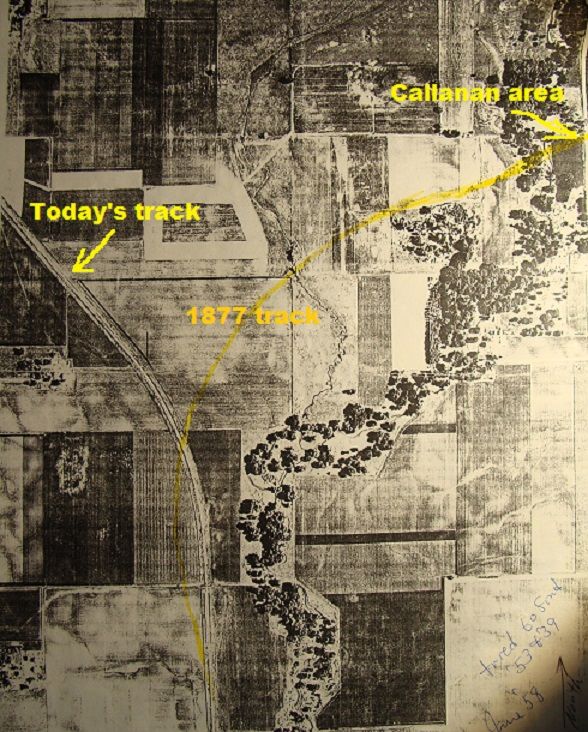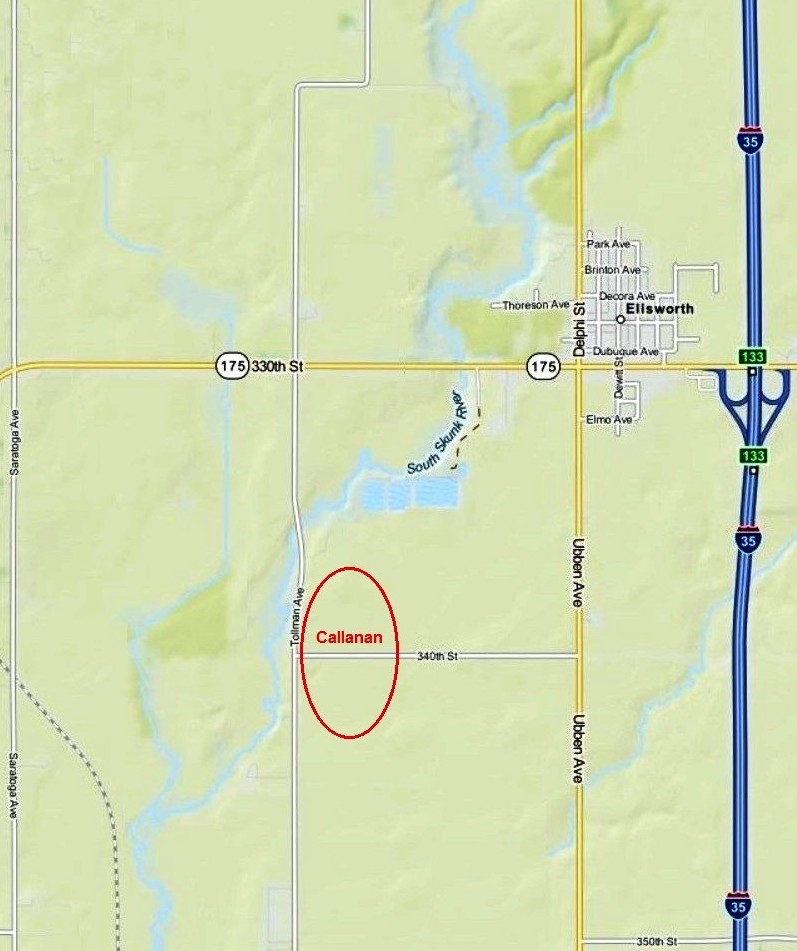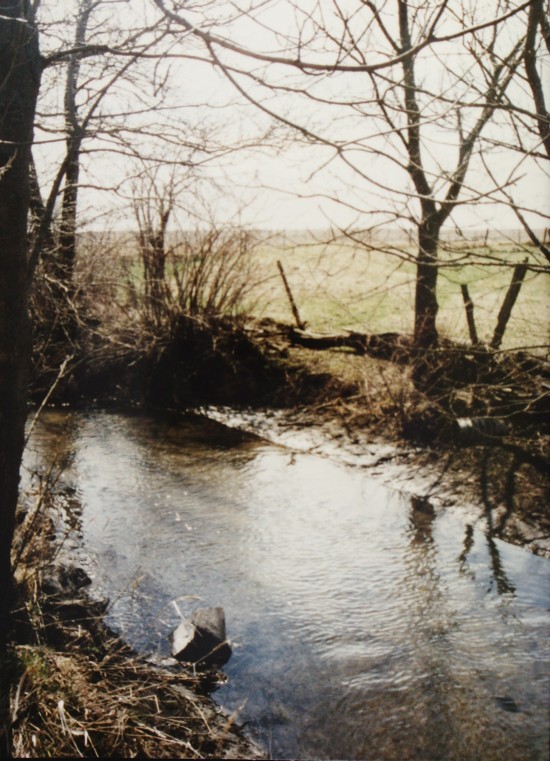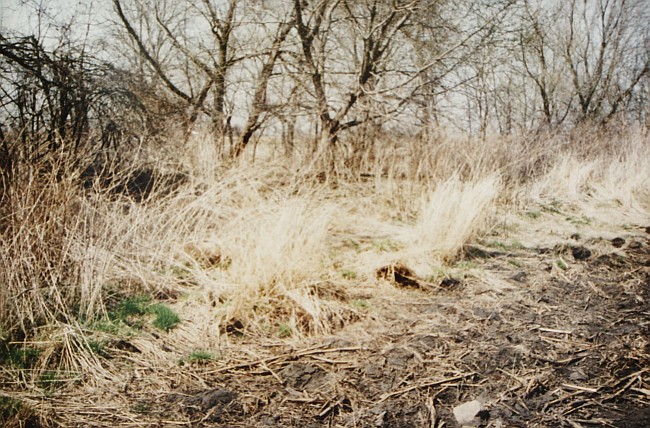|
In 1882, when the Toledo and Northwestern Railroad company was purchased
by the Chicago and Northwestern Railroad, the line was widened from
narrow gauge to standard and bypassed Callanan to head towards Jewell (Jewell
Junction) to junction with the Toledo and Northwestern RR line (the
east/west railroad). The railroad section crews assembled
along the line and changed it to standard gauge in one day, Sunday, May
28, 1882.
This bypass of Callanan insured that settlement
would only survive about three years, with most residents moving to either
Ellsworth or Jewell.
The birth of Callanan was
the death of Lakin's Grove. Most of the businesses and professional
men moved to the railroad town. Callanan, the first platted town
in southeast Hamilton County came into being in the spring of 1878 when
a Narrow Gauge Railroad, the Des Moines and Minneapolis, was built
north of Ames.
In the early spring of 1878,
a depot was built and the railroad was completed. The town was laid
out the same year. It was first given the name Lakin, but
when a post office was established, the railroad named it Callanan
for the president of the road.
Callanan grew like a mining
boom town. It was built in a great agricultural country and large
shipments of grain and livestock were sent out and needed commodities brought
in. It has been reported that 2 passenger trails - one north-bound,
the other south-bound, were in full operation daily.
By the fall of 1878, Callanan
had everything but law enforcement and a bank. There were two saloons
and all the things that went with them at the time. It was told they
each cleared more money than any other business.
Callanan lived and grew fast
for nearly three years, and lots of gambling and two murders were reported.
One murder was by a drunken bystander on the Fourth of July, who fired
a revolver into the crowd on the platform of the depot striking one Jacob
Heng on the leg. The doctor amputated the leg using the kitchen table
for the operation. Mr. Heng lived for about 3 weeks.
The other case was that in
which Hilga Espe killed Joe Isley. Espe was a storng, muscular fellow
shile Isley was a little old man. Both were drunk. Espe wanted
to fight Isley, but Isley refused and started to go away. Espe followed
and picked up the smaller man, threw him from the sidewalk upon the frozen
ground with great force and left him there. Someone at a distance
saw the act and went to the old man. Finding him unconscious, people
in the crowd took him, laid him upon a bench where he remained unconscious
until the next day when he died.
(More text from the The Centennial Story of Ellsworth is continued
below.) |
|
|
Scan of a 1958 IDOT image

This 1958 map, an aerial view of the Callanan area,
was secured from the Iowa DOT. North is up. It shows today's
railroad track coming up from Randall, and turning towards Jewell.
The curved line shows how the 1877 track turned towards the East, crossed
the Skunk river, and ended at the intersection of four townships in the
southeast corner of Hamilton County. |
When the railroad bypassed Callanan, and Ellsworth
needed a depot, the Callanan depot was pulled (on skids) to the new community
of Ellsworth to become the Ellsworth depot.

While no images are available for the town of Callanan,
several recent photos of that area nearby Callanan, travelled by the narrow
gauge railroad track, are seen below. The area is photograhed below,
and can be spotted in the IDOT map (seen above) directly above the words
Track
(1877) just to the left and right of the creek seen in that area.

This creek was west of the Skunk River in the Callanan
area.

|
Thriving Boom Town of Callanan
Callanan, the first platted
town in southeast Hamilton County, came into being before the spring of
1878, when a Narrow Gauge Railroad 3 feet wide, the Des Moines and Minneapolis,
was built north of Ames.
The railroad was being built
on the west side of Skunk River; but in order to get 5 per cent tax is
was required to come within a mile of the four adjoining corners of Lyon,
Lincoln, Ellsworth and Scott Townships. To do this it was necessary
to build a spur across the river. A high grade from the bridge to
the top of the hill east with an incline of five hundred feet to the mile.
This made a very steep long grade. The bridge and grade were supposed
to be only temporary just to get a train across by a given date in order
to collect the tax.
The grade was so steep to
get into Callanan that trains would take a long run and sometimes failed
to make it, had to back down and try again. Then the idea of backing
up the hill was used as the engine needed more push than pull. In
going out all brakes were set. This railroad expected to build north
through Webster City, but only a 21/2 per cent tax was voted so they stopped
at Callanan possibly to go northeast to Alden.
The town Callanan was being
started on the west side of section one of Ellsworth Township and section
36 of Lyon Township in the winter of 1877-78. The depot was on the
south side. In early spring, the Narrow Gauge Railroad was completed
and the town laid out on April 19, 1878. It was first called Lakin,
but when a post office was established, the railroad named it Callanan
for the president of the railroad.
In November 1878, the south
half of the southwest one fourth of section 36 of Lyon Township was laid
out in town lots and called North Callanan. Streets were laid out,
the business district evidently ran north and south with River, Main, Everett,
Willow, Scott, Lyon, Cherry and Vine; east and west streets were Lincoln
and Ellsworth. Later, there was made an addition to North Callanan
with River, Main and Vine Streets.
This settlement was built
in a great agricultural country and large shipments of grain and livestock
were sent out and needed commodities were brought in. In the
fall of 1878, Mr. Sherpy started the
Herald. In a copy of
the Herald dated December 14, 1878, it was noted that the subscription
was $1.00 per year if sent in clubs of five or more and before January
1st. "If you haven't any money, we won't object to several tons
of potatoes, cabbage or anything that can be eaten. Patronize your
home paper and save your country." The Herald had a hard
time to live, and Frank Bell was the editor after a few weeks. It
was revived again and the name cas changed to Register.
A school house was built and
a County Teacher's Institute was held in it. Professor Eldridge,
one of Iowa's noblest men and one of the best educators in the United States
conducted the classes. Louise Anderson, who later married Wig Bonner,
taught one of the first terms of school. Church and Sunday School
were held in the school house.
The Callanan people probably
used the Ringer Cemetery as some know people from Callanan had been buried
there earlier. It would be only about one and one half miles north.
This could account for the larger number of unmarked graves.
Although no bank had been
organized, by the fall of 1878, Callanan had everything but law enforcement
and a bank. There were two saloons and all the things that went with
them at the time. It was told that they each cleared more money than
any other buisiness.
Callanan lived and grew fast
for nearly three years. Lots of gambling and two murders were reported
there. One was by a drunken bystander on the Fourth of July, who
fired a revolver into the crowd on the platform of the depot. The
other case was that in in which Hilga Espe killed Joe Isley. Espe
was a strong, muscular fellow while Isley was a little old man. Both
were drunk. Espe wanted to fight Isley, but Isley refused and started
to go away. Espe followed and picking up the smaller man, threw him
from the sidewalk upon the frozen ground with great force, and left him
there. Someone at a distance saw the act and called the crowd from
the saloon and he was taken in and laid upon a bench where he remaind unconscious
until the next day, when he died.
(the above text is adapted from The Centennial Story of Ellsworth)
|


Dick Steffen and Dale Hughes are seen investigating
the narrow gauge roadbed to Callanan
while they accompany Alan Spohnheimer. The Callanan
narrow gauge track bed was on the
raised area on the other side of this fence.

The narrow gauge railroad bed is seen just above, where
no grass is seen.
|
Callanan, continued
A year passed by and the Narrow
Gauge Railroad remained in operation from Ames to Callanan. It has
been reported that 2 passenger trains - one north-bound, the other south-bound
- were in full operation daily. The railway company refused to go
north through Webster City unless they received the full 5 per cent tax.
However, they threatened to go north by way of Blairsburg or Williams unless
the 5 percent tax was conceded.
By 1880 it was realized that
the Chicago Northwestern was back of the Toledo and Northwestern
Railroad (east and west). So it was that on December 6, 1880 that
a regular passenger train made its first run on this line through Hamilton
County. Then, too, a transfer stage was put inot operation between
Ellsworth and Callanan, a distance of a little over a mile. So now
the people had railroad facilities both south to Des Moines and east to
Chicago.
In an old issue of the Callanan Herald, the
following 24 businesses and advertisers where listed in Callanan:
J.T. Haight, Attorney at Law and Notary Public
J.T. Livergood, homeopathic physician
G.W. Black, physician and surgeon
Charles Lakin, barber and hair dresser
J.D. Thompson, contractor and builder
S.J. Palmer, dealer in shelf and heavy hardware, Callanan
Brick Company
J.C.Clouse, house and carriage painter
J. Delorme, manuafacturer of boots and shoes.
Callanan House - good beds and tables
City Billiard Hall, J.R. Dink, proprietor, fresh bottled
beer, ales and pop
W.G. Ridhard and brother, selling goods at bedrock
prices for cash or produce
The Eagle Boarding House, H. Hoy, proprieter
J.G. Wheat, drugs, buggy and wagon grease
J.O. Ringstad and Chris Thoreson, general store
Allen and Ruddle, house painters
Swain G. Johnson & Co., dealers in dry goods,
groceries, ready made clothing, boots, shoes, paints, oils and general
merchandise
Charles Lakin, dealer in farm machinery of all kinds,
coal, hair, lime
P.T. Stein, proprietor, blacksmith, carriage and wagon
shop
Mr. Winter, constructing a large building
G.M. Barkhuff, meat market
Dr. Tremain
W.C. Barkhuff, wagon shop
Scandinavian Hotel, A. Anderson, proprietor.
Within a few years, most of the businesses of Callanan
moved to Ellsworth, and some to Jewell. After the town of Callanan
was gone, John Ringstad bought the land.
(this text has also adapted from The Centennial Story of Ellsworth)
|

Dick Steffen is facing east and can see where the railroad
track
headed towards the Skunk River and climb the hill
to enter Callanan.
Callanan Page (3)
Back Home
|

